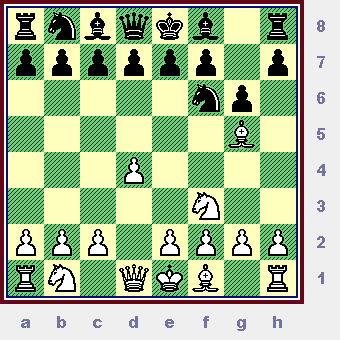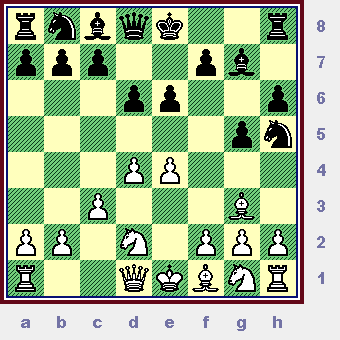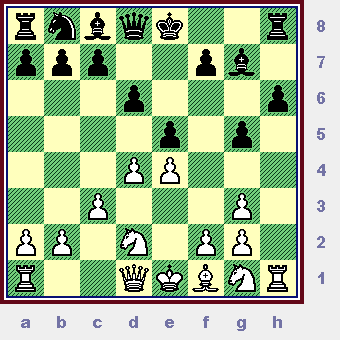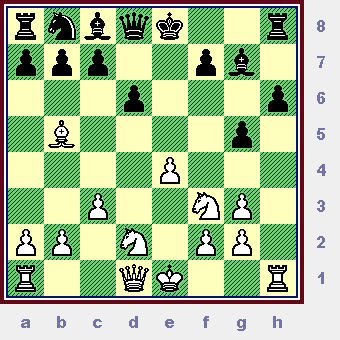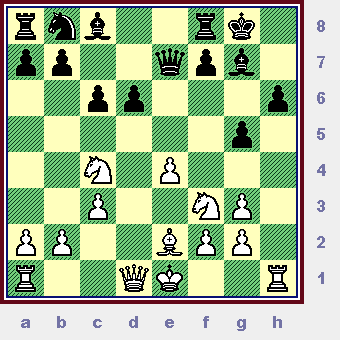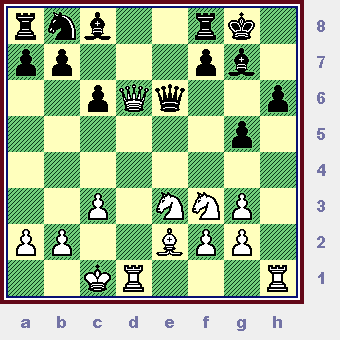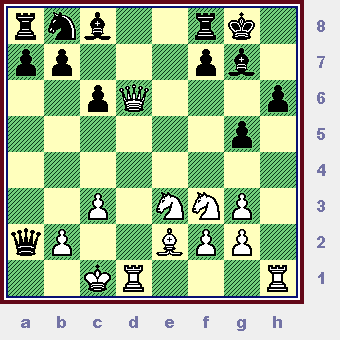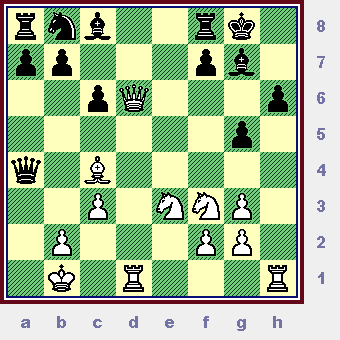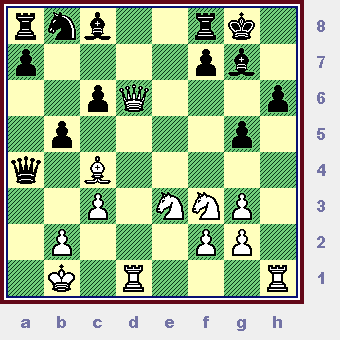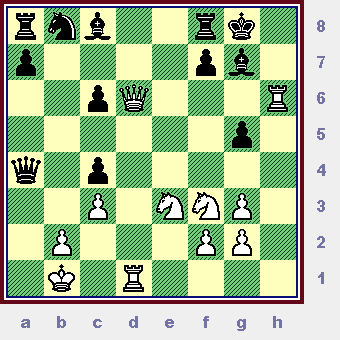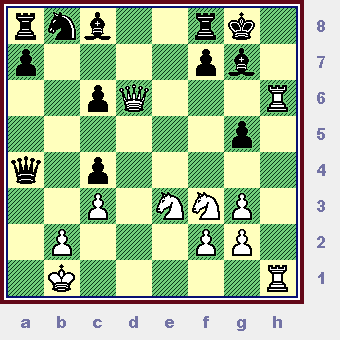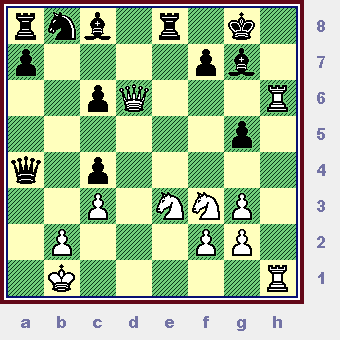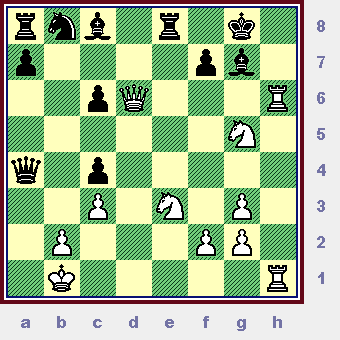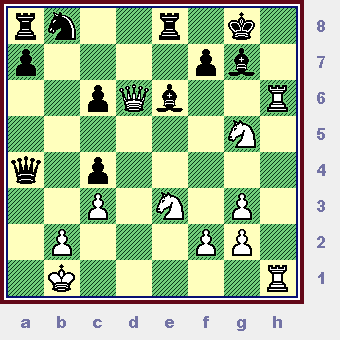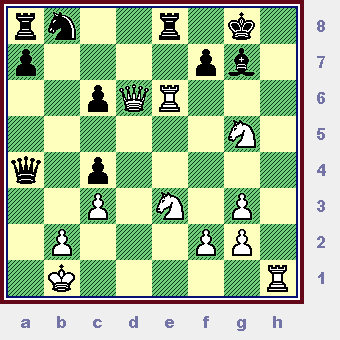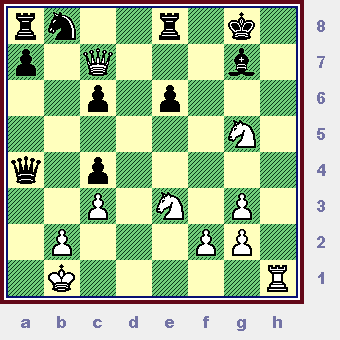GM Boris Gelfand
(2733) - GM Teimour
Radjabov (2729);
|
|
|
rnbqkb1r/pppppp1p/5np1/6B1/3P4/5N2/PPP1PPPP/RN1QKB1R b
Another game -
of recent vintage - (between strong players) would be:
GM Krishnan Sasikiran
(2700)
- GM Vasilios Kotronias
(2572); /
ICT, The Aeroflot Open
Moscow, RUS; (R #3) / 16,02,2007. {White
won a nice game in 38 total moves.}
[ After the moves of: 3.c4 Bg7; 4.Nc3 d5; we reach a Grunfeld.
[See MCO-14, beginning on page # 619 ... for more details on the Grunfeld Defense.]
A recent contest, that was finely played, would be:
GM Alexander Onischuk
(2663) - GM Emil Sutovsky
(2629); [D97]
ICT, 8th Karpov (40 moves.) /
Poikovsky, RUS;
(R#6) / 21,03,2007.
{White won a model
game.} ]
3...Bg7;
4.Nbd2 d6; 5.e4, "+/="
White immediately grabs the center.
(This is perfectly legitimate and conforms to the four basic principles of the opening.)
[ The "book" line would be:
5.c3 0-0; 6.e4 c5;
7.dxc5 dxc5; 8.Bc4 Nc6;
9.0-0 Qc7; 10.Qe2, "~"
when White might have a small edge in this position.
See the superb struggle: GM Krishnan Sasikiran
(2675) - GM Rustam Kasimdzhanov
(2672);
ICT,
The 15th Asia Classical (1-0) /
Doha, Qatar; (R #6) /
06,12,2006.
{White won a crushing positional masterpiece in forty-six moves.}
]
5...h6!?;
(Pawn structure.)
Black decides to immediately kick the Bishop, however, this does involve some weakening of the squares around Black's King.
[ Instead, after the moves of: (>/=)
5...0-0; 6.c3 c5;
we transpose into the last note.
(After
White's 5th move. - ye olde editor) ]
6.Bh4 g5;
7.Bg3 Nh5;
8.c3 e6; 9.Ng1!?, (tempo) {Diagram,
below.}
White decides to force Black to make a decision about his Knight on the h5-square. Instead,
9.Qb3, "+/=" ...
also offered the promise of something of an advantage for the first player as well.
|
|
rnbqk2r/ppp2pb1/3pp2p/6pn/3PP3/2P3B1/PP1N1PPP/R2QKBNR b
Please study this position for a few minutes ... if I may be so bold.
9...Nxg3;
Black snaps off the Bishop, but allows the h-file to be opened. (Black could have retreated his Knight back to f6, but this would have involved the loss of several tempi for GM T. Radjabov.)
10.hxg3 e5!?; {Diagram,
below.}
Black opts for the immediate strike at the center.
|
|
rnbqk2r/ppp2pb1/3p3p/4p1p1/3PP3/2P3P1/PP1N1PP1/R2QKBNR w
In my book, this is just a little bit risky, 10...Nc6; (or even 10...Nd7); might have been fractionally better.
11.dxe5 Bxe5;
Taking with the Pawn would have meant that the Bishop on g7 has been relegated to the traditional role of ...
"the bad Bishop."
12.Ngf3 Bg7; 13.Bb5+!?,
('!') {Diagram,
below.}
Since White has a Pawn on e4, his King's Bishop always faces the possibility of being a defender or hemmed in by the Pawns ... in any possible endgame.
|
|
rnbqk2r/ppp2pb1/3p3p/1B4p1/4P3/2P2NP1/PP1N1PP1/R2QK2R b
This bold stroke hopes for
13...Bd7; 14.BxB/d7+, NxB/d7; when White has the slightly better game ...
and has exchanged his KB with a gain of time.
[ Instead, Fritz gives us the line: 13.Qa4+
Qd7; 14.Qb3 Nc6; 15.0-0-0, "+/="
with a fair edge for White. ]
13...c6!?;
(Maybe - '?!')
Black decides to kick back the White Bishop, but this move entails a serious weakening of Black's Pawn structure.
(The button on d6 is now officially a backward Pawn.)
[ Instead, after the continuation:
(>/=) 13...Bd7; 14.Qb3 Nc6;
15.0-0-0 0-0; 16.Kb1, "+/="
Fritz sees a small advantage for White in this position.
(More space, and maybe better play.)
]
14.Be2 0-0;
15.Nc4, ("/\")
White decides to immediately go after the (newly weakened) d-pawn, and this is imminently logical.
[ Some programs prefer the play:
15.Qc2,
"+/=" (With the idea of: 0-0-0);
which is {also} a good move for White.
]
15...Qe7!?;
(An inferior defense?) {Diagram,
below.}
Black - perhaps discouraged by the sudden turn of events and the rapid decay of his position - does not find the best defense.
(See the note/variation just below, beginning with 15...d5.)
|
|
rnb2rk1/pp2qpb1/2pp3p/6p1/2N1P3/2P2NP1/PP2BPP1/R2QK2R w
In any event, Black has the worst of things, and it is hard to blame him for not wanting to defend the positions that contain an isolated Pawn, (and other weaknesses as well).
[ Black could also try:
(>/=) 15...d5;
16.exd5 cxd5; 17.Ne3 g4; 18.Nh4, "+/="
(Maybe -
'±'); but White remains clearly better ... in any case.
]
The next two moves look to be the best - for both sides.
16.Qxd6 Qxe4;
17.Ne3 Qe6;
18.0-0-0!?, (Maybe - '!') {Diagram,
below.}
This is - in effect - a Pawn gambit, and therefore very sharp.
|
|
rnb2rk1/pp3pb1/2pQq2p/6p1/8/2P1NNP1/PP2BPP1/2KR3R b
However, castling here could have allowed Black to exchange Queens, and for this reason I would have preferred to play 18.Qd2, to be followed by Bc4 and then 0-0-0. '±'
[ Another idea was: 18.Qc7, "+/=" with a healthy edge for White. ]
18...Qxa2?!;
(Over-aggressive?) {Diagram,
below.}
Black decides to "test" White's concept, although this looks rather risky to me.
|
|
rnb2rk1/pp3pb1/2pQ3p/6p1/8/2P1NNP1/qP2BPP1/2KR3R w
In my mind - this is simply too
dangerous for Black.
(Although this is with the benefit of hindsight, which ... of course! ... is always
20/20.)
[ Black's best defense was probably:
>/=
18...Qxd6; 19.Rxd6 Be6;
20.Nd4 Be5; 21.Nxe6 Bxd6; 22.Nxf8,
"+/=" (Maybe - '±')
although White would have still retained a hefty edge.
]
The next few ply are forced. {Diagram,
below.}
19.Bc4 Qa1+; 20.Kc2 Qa4+; 21.Kb1!,
This is the most thematic, (taking advantage of the fact that ...Bf5+ is impossible - as the WN covers
that square); although 21.Bb3 was also possible.
|
|
rnb2rk1/pp3pb1/2pQ3p/6p1/q1B5/2P1NNP1/1P3PP1/1K1R3R b
Now White's King will be almost perfectly safe, and all of his pieces are on good, active squares ... while the same cannot be said of the Black King (in this position).
[ The following continuation was also pretty good for White:
21.Bb3!? Qe4+!?; 22.Kc1 Nd7; 23.Bc2, "+/="
(Maybe - '±')
when White will have a strong
K-side assault. "--->" ]
21...b5!?; {Diagram,
below.}
This appears to be the most testing reply for Black ... and it really did not matter at this
point, anyway.
(Analysis reveals that Black is lost, no matter what line is chosen here.)
|
|
rnb2rk1/p4pb1/2pQ3p/1p4p1/q1B5/2P1NNP1/1P3PP1/1K1R3R w
Now all serious students of the game should study this position carefully.
[ Fritz gives the line:
(>/=) 21...Be6;
22.b3! Qa5; 23.Bxe6 Qxc3!?;
{Diag?}
(A last ditch try, if 23...Bxc3;
then 24.Nc4, "+/-" is decisive.)
24.Nd4, "+/-" but White is also winning
in this position as well. ]
Now the fireworks erupt.
22.Rxh6!!,
This sack is very strong ... although such a thematic move could hardly be labeled an original idea here.
[ Also good was the try: 22.Nd4!!, "+/-" with ideas similar to those of the actual game. ]
22...bxc4;
("[]") The best defense? {Diagram,
below.}
Now this is forced, otherwise Black has to give up the battle.
|
|
rnb2rk1/p4pb1/2pQ3R/6p1/q1p5/2P1NNP1/1P3PP1/1K1R4 w
Now how does White follow up with his attack?
[ Even worse would be:
</= 22...Bxh6?;
23.Qg6+! Bg7[]; 24.Rh1!,
"+/-"
when Black has to play ... "give-away" to prevent the
impending mate on h7. ]
23.Rdh1,
('!') [Attack - down the h-file.] {Diagram,
below.}
This is nice ... but it is also the only consistent move for White in this position.
|
|
rnb2rk1/p4pb1/2pQ3R/6p1/q1p5/2P1NNP1/1P3PP1/1K5R b
Now White threatens to drop the
hammer with 24.Rh8+!, ... ... ...
among other things.
[ But not: </= 23.g4? Qa5; "=/+" when Black might get away. ]
23...Re8;
(hmmmm) {Diagram,
below.}
This looks to be Black's best practical attempt at defending his position. (No more hanging Rook on f8.)
|
|
rnb1r1k1/p4pb1/2pQ3R/6p1/q1p5/2P1NNP1/1P3PP1/1K5R w
Now it is not really 100% clear how White is to continue from the current position that we have on the board.
[ Black also loses after:
(>/=) 23...Qb5!?; 24.Rh8+!! Bxh8;
25.Rxh8+!,
This is the most forceful follow-up.
(But not: </= 25.Qh6? Bf5+!; "-/+" as Black has turned the tables!)
25...Kxh8; 26.Qxf8+ Kh7; 27.Qxf7+ Kh8; 28.Qf8+ Kh7;
29.Qxc8, "+/-"
when the only way that Black can prevent further material loss
is to allow his
King to be mated. ]
24.Nxg5!, {Diagram,
below.}
The most logical, a fresh piece is brought into the attack on the Black King.
|
|
rnb1r1k1/p4pb1/2pQ3R/6N1/q1p5/2P1N1P1/1P3PP1/1K5R b
Now White's attack is overwhelming,
most chess engines begin to see the impending mate from this position.
(Now White threatens a double Rook sack on h8, followed by Qh6+, Qh7+,
and then QxP/f7 mate.)
[ GM T. Radjabov would have turned the tables on White ... after the following continuation:
</= 24.Rh8+? Bxh8; 25.Rxh8+
Kxh8; 26.Qh6+ Kg8; 27.Nxg5!? Bf5+!; "-/+"
when Black is winning in all lines,
because if the Bishop (on f5) is captured, then 28...Re1#; is mate. ]
24...Be6;
(Forced?!?) {Diagram,
below.}
Practically the only move ... Black mechanically blocks the WQ from reaching the h6-square.
(Fritz offers to start throwing all of Black's pieces on the bonfire ... as the only way to prevent the impending mate.)
|
|
rn2r1k1/p4pb1/2pQb2R/6N1/q1p5/2P1N1P1/1P3PP1/1K5R w
Now the only question is: "Will White find the most forceful way to continue from this position?"
25.Rxe6!, {Diagram,
below.}
The answer is a resounding "YES!," Radjabov could have resigned here ... this would have made this game an attractive
miniature chess game.
|
|
rn2r1k1/p4pb1/2pQR3/6N1/q1p5/2P1N1P1/1P3PP1/1K5R b
Here is the current situation that we have on the chess board.
[ White could also win with: </=
25.Nxe6!? fxe6; 26.Nf5!!
exf5!?; 27.Qg6!, "+/-"
when White's main threat is (now) Rh8 mate, but this is enough to resolve the struggle in White's favor. ]
25...fxe6;
I don't think it mattered what Black played in this position. (See the variation given below.)
[ Or Black could have tried:
</=
25...Rxe6?!; 26.Qd8+ Bf8;
27.Rh8+ Kg7[]; 28.Qxf8+ Kf6; 29.Qxf7+ Kxg5;
30.f4#. ]
26.Qc7,
"+/-" (Fritz -- is
showing a mate in six moves ... at most.) {Diagram,
below.}
Black resigned as White threatens a mate in one, (Qf7#); and 26...Rf8; is easily met 27.Rh7, when White's threats are impossible to meet.
|
|
rn2r1k1/p1Q3b1/2p1p3/6N1/q1p5/2P1N1P1/1P3PP1/1K5R b
A wonderful effort by
GM Gelfand, and
a game most of us wished that we could have played with full sight of the board ...
especially considering
the strength of the opposition here!
Copyright (c) A.J. Goldsby, 2007. All rights reserved.
